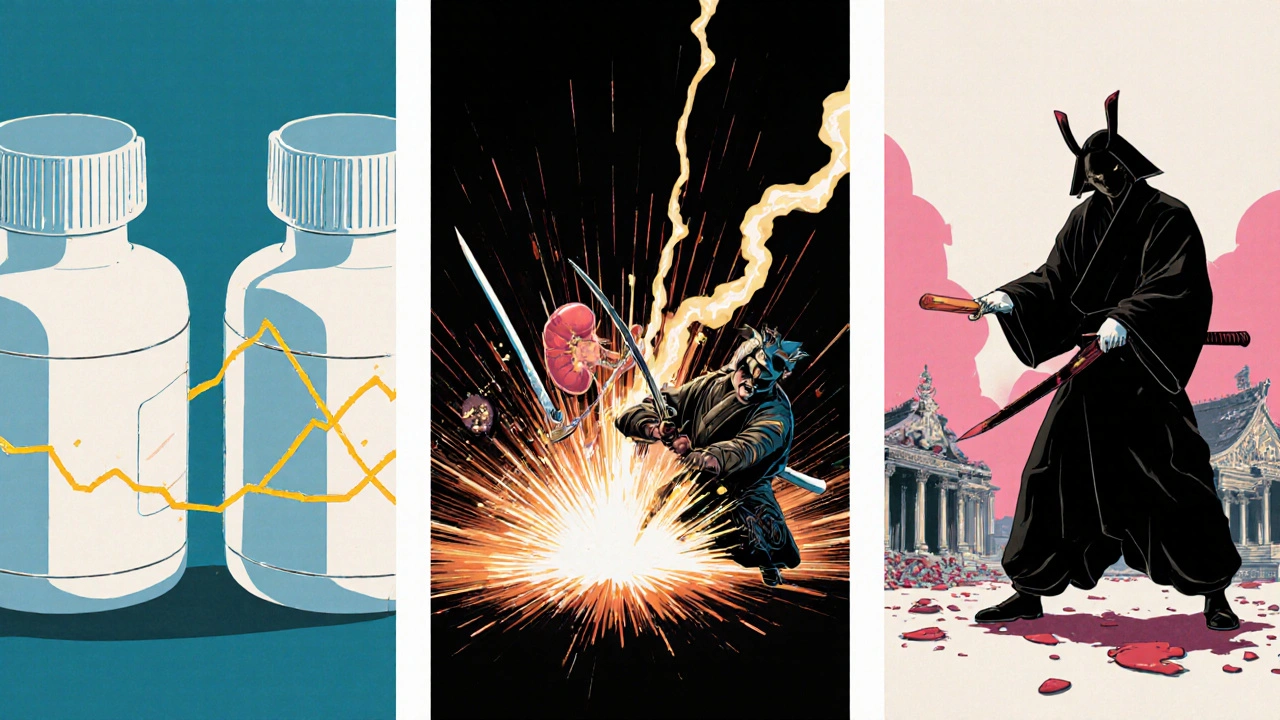When you take two drugs at the same time, they don’t just sit in your body doing their own thing. Sometimes, they talk to each other-and not always in a good way. This is where pharmacodynamic drug interactions come in. Unlike interactions that change how your body absorbs or breaks down a drug, pharmacodynamic interactions happen right at the target site: the receptor, the cell, or the organ. One drug changes how another drug works-without changing its concentration in your blood. That’s why these interactions are sneaky. Even if your lab tests show normal drug levels, you could still have a dangerous or useless response.
How Pharmacodynamic Interactions Work
Think of receptors as locks and drugs as keys. Each drug is shaped to fit a specific lock. When two drugs try to use the same lock, one can block the other. That’s receptor competition. For example, if you’re on albuterol for asthma and your doctor prescribes propranolol for high blood pressure, you’re in trouble. Propranolol blocks the same beta-2 receptors that albuterol needs to open up your airways. The result? Your inhaler stops working. No matter how much you use it, your breathing won’t improve.
This isn’t just theoretical. In hospital settings, about 40% of serious drug interactions are pharmacodynamic, according to studies of over 12,000 patient records. These aren’t rare edge cases-they’re common enough that exam boards like the CICM require doctors to memorize specific examples. And it’s not just about blocking. Drugs can also team up.
Three Types of Pharmacodynamic Interactions
There are three main ways drugs can interact at the pharmacodynamic level:
- Additive: The combined effect is equal to the sum of each drug’s individual effect. For example, taking acetaminophen and codeine together gives you more pain relief than either alone-but not dramatically more.
- Synergistic: The combined effect is greater than the sum. This is the good kind, when used intentionally. Trimethoprim and sulfamethoxazole (Bactrim) work this way. They block two different steps in bacterial folic acid production. Together, they kill bacteria more effectively than either drug alone, allowing lower doses and reducing side effects.
- Antagonistic: One drug reduces or cancels out the effect of another. This is the dangerous kind. NSAIDs like ibuprofen can blunt the blood pressure-lowering effect of ACE inhibitors by cutting kidney blood flow by up to 25%. That’s not a small drop-it can mean your hypertension goes uncontrolled, raising your risk of stroke or heart attack.
Some antagonistic interactions are life-threatening. Mixing SSRIs like sertraline with MAOIs like phenelzine can trigger serotonin syndrome-a condition where your nervous system goes into overdrive. Symptoms include high fever, seizures, irregular heartbeat, and even death. A 2021 meta-analysis found this combination increases serotonin syndrome risk by 24 times. That’s not a risk you take lightly.
Why Some Combinations Are More Dangerous Than Others
Not all drugs are created equal when it comes to interaction risk. The real danger lies in drugs with a narrow therapeutic index-meaning the difference between a helpful dose and a toxic one is tiny. Think warfarin, digoxin, lithium, or certain seizure medications. If a second drug changes how your body responds to one of these, even a small shift can cause overdose or treatment failure.
Studies show that 83% of life-threatening pharmacodynamic interactions involve at least one drug with a therapeutic index below 3.0. For example, if you’re on digoxin for heart failure and start taking clarithromycin (an antibiotic), your digoxin levels might not change-but your heart’s sensitivity to it can. That means you could develop dangerous arrhythmias even with normal blood levels.
Another high-risk group: central nervous system depressants. Combining opioids, benzodiazepines, alcohol, or sleep aids can slow your breathing to a stop. A 2020 analysis found that 68% of serious adverse events from pharmacodynamic interactions led to hospitalization-compared to just 42% for pharmacokinetic interactions. Why? Because you can’t just lower the dose of one drug to fix it. If two drugs both depress breathing, reducing one might not be enough.

When Interactions Are Intentional
Not all pharmacodynamic interactions are bad. Medicine often uses them on purpose. The combination of naltrexone (an opioid blocker) with low-dose antidepressants has shown promise in treating treatment-resistant depression. In a 12-week trial, 68% of patients improved with the combo, compared to 42% on antidepressants alone. The theory? Naltrexone tweaks brain opioid receptors in a way that boosts the antidepressant’s effect.
Similarly, the antibiotic combo of trimethoprim and sulfamethoxazole works because it hits bacteria at two points in their metabolic pathway. This isn’t just theory-it’s standard practice. In fact, this synergy reduces the needed dose of each drug by 75%, lowering side effects while improving effectiveness.
What Doctors and Pharmacists Are Doing About It
Despite how common these interactions are, they’re still missed. A 2022 survey of over 1,200 physicians found that 63% ran into a dangerous pharmacodynamic interaction at least once a month. The most frequent culprits? Anticoagulants with antiplatelet drugs (like aspirin and warfarin) and multiple CNS depressants.
One pharmacist on Reddit shared a near-fatal case: an elderly patient on linezolid (an antibiotic) and sertraline (an antidepressant) developed full-blown serotonin syndrome. It took 72 hours in intensive care to stabilize them. That’s not an outlier. These cases happen more often than you think.
Technology helps-but it’s not perfect. Clinical decision support systems in hospitals reduce errors by 37%, but they still miss 22% of significant interactions. Why? Many systems only flag known pharmacokinetic changes, not subtle receptor-level effects. The best defense? A pharmacist-led medication review. A 2021 review in BMJ Quality & Safety found these reviews cut adverse events by 58% in elderly patients, especially when it came to NSAID-antihypertensive clashes.
What You Can Do
If you’re on multiple medications, don’t assume your doctor knows every possible interaction. Ask these questions:
- Is there a chance these drugs could cancel each other out?
- Could they make each other too strong?
- Am I on any drug with a narrow therapeutic index?
- Has my pharmacist reviewed all my meds-including over-the-counter and supplements?
Even something as simple as ibuprofen can interfere with your blood pressure meds. And melatonin? It might seem harmless, but it can enhance the sedative effect of benzodiazepines. Always tell your prescriber what you’re taking-even if you think it’s “just a vitamin.”
Keep a written list of all your medications, including doses and why you take them. Bring it to every appointment. If you’re unsure about a new prescription, ask your pharmacist before filling it. They’re trained to spot these hidden conflicts.
The Future of Drug Interaction Safety
Regulators are catching up. Since 2017, the FDA has required pharmacodynamic interaction studies for new CNS drugs. In 2023, they expanded this to a pilot program covering all new drugs targeting the brain. The European Medicines Agency now requires these studies in 34% of new drug applications-up from 19% in 2015.
Researchers are building smarter tools. Dr. Rada Savic’s team at UCSF developed a machine learning model that predicts serotonin syndrome risk with 89% accuracy. The UK’s NHS is piloting real-time alerts in electronic health records that flag dangerous combinations before the prescription is even written.
As the global population over 65 hits 1.5 billion by 2050-and the average older adult takes nearly five prescription drugs-these interactions won’t go away. They’ll grow. The good news? We’re getting better at seeing them. The better news? You don’t have to wait for technology to save you. Knowledge is your best shield.
What’s the difference between pharmacodynamic and pharmacokinetic drug interactions?
Pharmacokinetic interactions change how your body handles a drug-like how fast it’s absorbed, broken down, or cleared. For example, grapefruit juice slows the breakdown of some statins, causing higher blood levels. Pharmacodynamic interactions don’t change the drug’s level in your blood. Instead, they change how the drug works at its target site-like one drug blocking the receptor another drug needs to activate.
Can over-the-counter drugs cause pharmacodynamic interactions?
Yes. Common OTC drugs like ibuprofen, naproxen, and even antihistamines can interact. Ibuprofen can reduce the effectiveness of blood pressure medications by affecting kidney function. Diphenhydramine (Benadryl) can add to the sedation of antidepressants or sleep aids. Even herbal supplements like St. John’s wort can alter brain chemistry and interfere with antidepressants or birth control.
Are pharmacodynamic interactions more dangerous than pharmacokinetic ones?
They can be. While pharmacokinetic interactions are more common, pharmacodynamic ones are more likely to cause serious harm. A 2020 study found that 68% of serious adverse events from drug interactions were due to pharmacodynamic effects, compared to 42% from pharmacokinetic ones. This is because pharmacodynamic interactions often affect vital systems like breathing or heart rhythm, and you can’t always fix them by adjusting the dose.
How do I know if I’m at risk for a pharmacodynamic interaction?
You’re at higher risk if you take three or more medications, especially if any have a narrow therapeutic index (like warfarin, digoxin, or lithium). Also, if you’re elderly, have kidney or liver disease, or take CNS drugs (antidepressants, opioids, sedatives), your risk goes up. If you’ve had unexplained side effects-like sudden dizziness, confusion, or trouble breathing-after starting a new drug, ask your doctor about a possible interaction.
Should I stop taking a medication if I’m worried about an interaction?
Never stop a prescribed medication without talking to your doctor or pharmacist. Some interactions can be managed by switching drugs, changing the dose, or spacing out administration times. Stopping suddenly can be dangerous-especially for blood pressure, seizure, or mental health medications. Always get professional advice first.
Understanding pharmacodynamic interactions isn’t just for doctors. It’s for anyone taking more than one medication. The more you know, the safer you are.


swatantra kumar
November 19, 2025 AT 19:40robert cardy solano
November 21, 2025 AT 07:17Pawan Jamwal
November 23, 2025 AT 01:32Bill Camp
November 23, 2025 AT 20:02Lemmy Coco
November 24, 2025 AT 18:04rob lafata
November 24, 2025 AT 23:27Matthew McCraney
November 26, 2025 AT 13:49serge jane
November 28, 2025 AT 06:22Nick Naylor
November 28, 2025 AT 20:59Brianna Groleau
November 30, 2025 AT 04:19